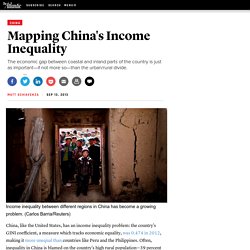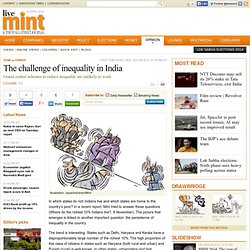

Who is left behind? - Money - CBC Player. Unrest in China: A dangerous year. Mass Poverty and Social Inequality in India: The Devastating Impacts of the Neoliberal Economic Development Model. Back in 2008, Indian finance minister P.

Chidambaram claimed that his government’s policies were pro growth and pro equity (1). Why inequality in India is on the rise. Sanghamitra Bandyopadhyay explains how poor fiscal management and inadequate infrastructure drive economic polarisation.

The rise in global inequality is big news in both popular and academic literature. Much of the economic literature attributes this to the fast growth of rich nations and the relative slower growth of poorer nations. A similar picture describes India. It is a well-established middle-income country in terms of its gross GDP: at US$1.95 trillion in 2012, India is the tenth richest country in the world. The country is also macroeconomically robust, having maintained moderately stable fiscal and monetary bases since 1950.
Mass Poverty and Social Inequality in India: The Devastating Impacts of the Neoliberal Economic Development Model. Inequality threatens Asia growth miracle. Economic inequality: In sickness and in health. ADB: Rising income inequality a threat to Asia's growth. MANILA, Philippines - Developing Asia's rapid growth in recent years has given rise to a widening rich-poor divide that threatens to undermine the region's growth and stability, but governments can address the problem via shifts in spending priorities, the Asian Development Bank said.

The region must spend more on education and health, create quality jobs and invest in infrastructure to reduce imbalances between developed and lagging rural areas so as to prevent social problems that can lead to inefficient populist policies, the Manila-based ADB said on Wednesday. In its Asian Development Outlook 2012 report, the bank said if inequality in the region had remained stable over the past two decades, growth over the years would have lifted 240 million people more out of poverty, the equivalent of 6.5 percent of developing Asia's population in 2010. But instead, inequality widened even as Asia's economic growth took off. Developing Asia is set to grow 6.9% this year, slowing from 7.2% in 2011. WPS6719. What We’re Reading: Asian Development Bank will focus on lending to tackle inequality.
Mapping China's Income Inequality - Matt Schiavenza. Income inequality between different regions in China has become a growing problem.

(Carlos Barria/Reuters) China, like the United States, has an income inequality problem: the country's GINI coefficient, a measure which tracks economic equality, was 0.474 in 2012, making it more unequal than countries like Peru and the Philippines. Often, inequality in China is blamed on the country's high rural population—39 percent of China's citizens worked in the agricultural sector in 2008, a number much higher than that of developed economies. The situation isn't lost on China, either. Prime Minister Li Keqiang has unveiled a plan to urbanize the country, betting that doing so would help balance China's economy. But there's a lot of evidence that inequality is more than just a binary issue of urban versus rural: significant regional differences exist, too. But the second and third maps reveal something a little less obvious. Rising Inequality Hurts India’s Human Development - India Real Time. The challenge of inequality in India.
In which states do rich Indians live and which states are home to the country’s poor?

In a recent report, Mint tried to answer these questions (Where do the richest 10% Indians live? , 6 November). The picture that emerges is linked to another important question: the persistence of inequality in the country. The trend is interesting. States such as Delhi, Haryana and Kerala have a disproportionately large number of the richest 10%.
China's income gap solution: Too little, too late? Communist Party leader Xi Jinping By Minxin Pei FORTUNE -- Few would disagree that reducing China's disturbingly high level of income inequality is one of the most difficult but critical challenges facing the nation's new leadership, headed by Xi Jinping.

Both official figures and scholarly estimates paint a worrisome picture of unprecedented income and wealth disparity that will likely grow worse in the future. Reducing inequality a priority[1] At the Third Plenary Session of the 18th Communist Party of China Central Committee, how to reduce income inequality will be a key issue.
![Reducing inequality a priority[1]](http://cdn.pearltrees.com/s/pic/th/reducing-inequality-chinadaily-73459735)
When he became China's top leader, Xi Jinping made helping all Chinese people to achieve modest prosperity and the rejuvenation of the nation the goals for his time at the helm. But reducing the huge income gap is a daunting task, as in recent years there has been no noticeable progress in reducing China's high Gini coefficient of 0.474, which indicates a high degree of inequality, and it is at a level above that in many long-established capitalist economies, where successful risk-taking earns rewards. In the developed countries some highly successful, risk-taking entrepreneurs, such as Bill Gates, Steve Jobs and Richard Branson, command respect for their wealth rather than jealousy, and they are seen as role models inspiring others. India has a problem with inequality, and it won't be solved easily. The Forbes list of billionaires features 55 Indians in 2013. The estimated net worth of only the top ten is $102.1 billion or approximately 5.5 per cent of India's gross domestic product.
Paradoxically, every third poor person and every second malnourished child in the world is also an Indian. India also adds 7.5 million babies with low birth weight annually, the highest anywhere in the world. In 2011, India was 73rd out of 88 countries listed in the annual Global Hunger Index , six places down from the previous year. The 2010 Multidimensional Poverty Index indicated that eight Indian states account for more poor people (421 million) than in the 26 poorest African countries (410 million) combined.
Deepening Divide: Can Asia Beat the Menace of Rising Inequality? Description Beneath the gloss of Asia’s newfound prosperity lies an unsettling reality.

Rising inequality has denied the benefits of Asia’s economic growth to many millions of its citizens. The problem is worsening as the region’s rich get richer much faster than the poor, who miss out on the income, education, and health care they need to lead fulfilling lives. Asia isn’t the only region suff ering from a wealth gap, but unlike others it has failed so far to narrow the divide. GINI index. Rural India marches on Delhi over landless poor. Could not load plugins: File not found Tens of thousands of landless peasant farmers gather in Gwalior in north India to march to the capital, New Delhi, to demand their right to land Link to video: India's landless march to Delhi The bus left Badpura village, bounced down a dirt track leading to where the buffalo bathe, then along a narrow lane through scrappy fields and out on to the main road.

From the vehicle's windows green and white flags flew. Inside were a dozen or so landless peasant farmers, heading to Delhi, the capital, to confront their nation's leaders and press their right to land. So far the marchers, 50,000-strong according to the organisers, have covered around 80 kilometres, not even a quarter of the distance they hope to travel. Protests In India Against The Inequalities Of The Capitalist Consumerist Business Model. Indonesian Protesters Demand Higher Wages. Finance & Development, September 2011 - Equality and Efficiency. Finance & Development, September 2011, Vol. 48, No. 3 Andrew G.

Berg and Jonathan D. Ostry PDF version Is there a trade-off between the two or do they go hand in hand? IN his influential 1975 book Equality and Efficiency: The Big Tradeoff, Arthur Okun argued that pursuing equality can reduce efficiency (the total output produced with given resources). Do societies inevitably face an invidious choice between efficient production and equitable wealth and income distribution? In a word, no. Rising Inequality Hurts India’s Human Development - India Real Time. ADB: Rising income inequality a threat to Asia's growth. Effects of Income Inequality on Growth through Efficiency Improvement and Capital Accumulation. Income Inequality, Wealth, and Illicit Financial Flows in Asia « Financial Transparency Coalition. Income Inequality, Wealth, and Illicit Financial Flows in Asia « Financial Transparency Coalition.
Income Inequality, Wealth, and Illicit Financial Flows in Asia « Financial Transparency Coalition. President Barack Obama Comments on Economic Mobility (Video) Last Updated on Thursday, 05 December 2013 05:09. Confronting rising inequality in Asia. Confronting rising inequality in Asia. Income inequality in Asia - Big Ideas. Human cost of China’s hukou system. Home -Policies-National Policy on Skill Development:Ministry of Labour and Employment, Government of India. Wen: China to continue to develop western region.
(Xinhua) Updated: 2009-10-16 10:48. Microsoft Word - EAIBB 715-China's western region devt 10 years on.doc - BB715.pdf. Deepening Divide: Can Asia Beat the Menace of Rising Inequality? Development Asia - devasia14.pdf. Finance & Development, September 2011 - Equality and Efficiency. Income inequality - Canada and world results. Key Messages Canada gets a “C” grade and ranks 12th out of 17 peer countries.